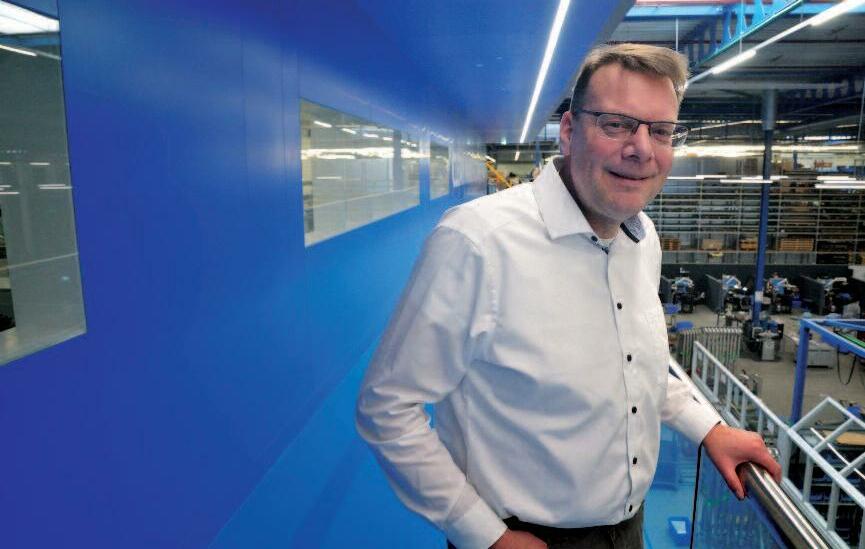INDUSTRY POLICY
DUTCH EQUIPMENT SECTOR IMPORTANT IN EU BATTLE FOR WORLD HEGEMONY IN SEMICON
‘WE WILL REALLY HAVE TO FIGHT TO STRENGTHEN OUR POSITION’ Following the US, the EU has now also proposed a Chips Act. The aim is to bring a bigger slice of the crucial semicon pie to the continent. In Europe, the billions of euros in subsidies will end up with a limited number of companies and institutes in just a few countries. Naturally the Netherlands is one of them, given its strong equipment sector led by ASML. But it is important that the focus is on the complete value chain, including the chip fabs. ‘Europe will really have to fight to strengthen its position, by going back to doing more itself.’
Semicon markets by region in billions of dollars (Gartner, ASML, April 2021)
BY MARTIN VAN ZAALEN
D
espite the war in the Ukraine and the resulting global political tensions demanding all of his attention, President Joe Biden did manage to attend a meeting with the leaders of the US semiconductor industry in mid-March. Which demonstrates the enormous importance the country attaches to strengthening this sector, ‘of fundamental importance for the US economy and for a range of production sectors in the US’. On the agenda was the CHIPS for America Act, a piece of legislation that aims to strengthen the semiconductor industry. In June of last year, the Senate released $39 billion for building chip fabs and $11.2 billion for R&D activities around semiconductors. The participants at the semicon summit wanted to
10
know when the relevant subsidies, tax breaks and research funding would be available.
EU CHIPS ACT The realisation has also dawned on politicians in Europe that a substantial slice of the semiconductor industry needs to be assured within the EU as quickly as possible. Whereas the Americans complain about the fact that semiconductor production capacity in the US has fallen from 37% in 1990 to 12% today, the European share of the semicon global market has fallen further, from 20% in 1990 to 8% now. The European Semiconductor Industry Association, by the way, keeps it at 9.4% now, barely less than the 10.1% share that the EU had 1995, according to ESIA. Remains that it is a meager share. So the EU has drafted its own Chips Act, which it launched in February, to restore that share to 20% by 2030. With a
Special High-tech The Netherlands - April 2022
raft of measures, the European act aims to free up €43 billion in public and private funding in order to enhance the ‘technological leader-ship’ of the European semicon sector and prevent future shortages of chips.
A TENTH OF WHAT IS NEEDED As far as Bram Nauta is concerned, that €43 billion, spread over 10 years, is only a tenth of what is needed in order to get market share back up to 20%. Because over that period, the market will double. And €43 billion is roughly the amount China spends on its semiconductor sector annually. ‘So at best, the extra money will be enough to keep the share at the current 8%.’ But the professor of IC Design at Twente University says he does understand that pumping €430 billion of tax money into a sector that has been making big profits for many years is not realistic. ‘So those billions of euros of public money need to be used primarily for tomorrow’s semicon. That means training enough people – especially in IC design, because there is a real shortage of specialists in that field – and research into new IC technology. The money needs to be spent in such a way that it boosts the profits of companies in the sector, which they then reinvest in their activities in Europe. That way, you could achieve a lot.’
GERMANY The Chips Act aims to build on the existing world-class European semicon sector, made up of R&D organisations and networks, chip fabrication plants, equipment manufacturers and specialist suppliers. The European semiconductor ecosystem is concentrated in a limited number of countries. Leuven in Belgium is home to IMEC, generally regarded as the most important research institute for this sector, alongside the Laboratory of Electronics and Information Technology (LETI) in France and the Fraunhofer Institute in Germany. Infineon and Robert Bosch have major chip manufacturing facilities in












